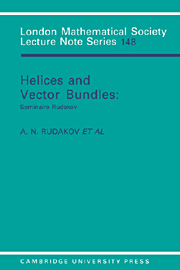Book contents
- Frontmatter
- Contents
- Exceptional Collections, Mutations and Helixes
- Construction of Bundles on an Elliptic Curve
- Computing Invariants of Exceptional Bundles on a Quadric
- Exceptional Bundles of Small Rank on P1 × P1
- On the Functors Ext* Applied to Exceptional Bundles on P2
- Homogeneous Bundles
- Exceptional Objects and Mutations in Derived Categories
- Helixes, Representations of Quivers and Koszul Algebras
- Exceptional Collections on Ruled Surfaces
- Exceptional Bundles on K3 Surfaces
- Stability of Exceptional Bundles on Three Dimensional Projective Space
- A Symmetric Helix on the Plücker Quadric
- Index
Exceptional Collections, Mutations and Helixes
Published online by Cambridge University Press: 03 May 2010
- Frontmatter
- Contents
- Exceptional Collections, Mutations and Helixes
- Construction of Bundles on an Elliptic Curve
- Computing Invariants of Exceptional Bundles on a Quadric
- Exceptional Bundles of Small Rank on P1 × P1
- On the Functors Ext* Applied to Exceptional Bundles on P2
- Homogeneous Bundles
- Exceptional Objects and Mutations in Derived Categories
- Helixes, Representations of Quivers and Koszul Algebras
- Exceptional Collections on Ruled Surfaces
- Exceptional Bundles on K3 Surfaces
- Stability of Exceptional Bundles on Three Dimensional Projective Space
- A Symmetric Helix on the Plücker Quadric
- Index
Summary
We shall give a general axiomatic presentation of the theory of helices and introduce some general definitions and notations.
Research on exceptional bundles was started in Moscow University after a lecture given by A.N. Tyurin given in the autumn of 1984 on a preprint of [1], In that paper a theorem is given describing the possible Chern classes which a stable bundle on P2 can have. Exceptional bundles appeared as some sort of boundary points. The results of the first one and a half years of our work were presented in [4]. Papers [3] and [6] together with subsequent papers represent the research of the following one and a half years. Most of the papers use a technique which should be called Helix Theory.
The definition of a helix and the first results about helices appeared in [4]. The key lemma 2.2 of that paper and the first version of the definition of a helix are due to Gorodentsev [3]. These constructions were a generalisation to arbitrary dimensions of a method of Rudakov which assigned an exceptional bundle on a projective plane to a pair of exact sequences [5]. The word “helix” and the idea of considering a helix as an infinite system of bundles with some form of periodicity is due to W.N. Danilov.
Further development of the notion of a helix was connected with applications of the primary ideas in new contexts. This was done by Gorodentsev for arbitrary categories of coherent sheaves [3], by Rudakov for a category of symmetric sheaves on a two-dimensional quadric [6] and by others in subsequent papers.
- Type
- Chapter
- Information
- Helices and Vector BundlesSeminaire Rudakov, pp. 1 - 6Publisher: Cambridge University PressPrint publication year: 1990
- 9
- Cited by



